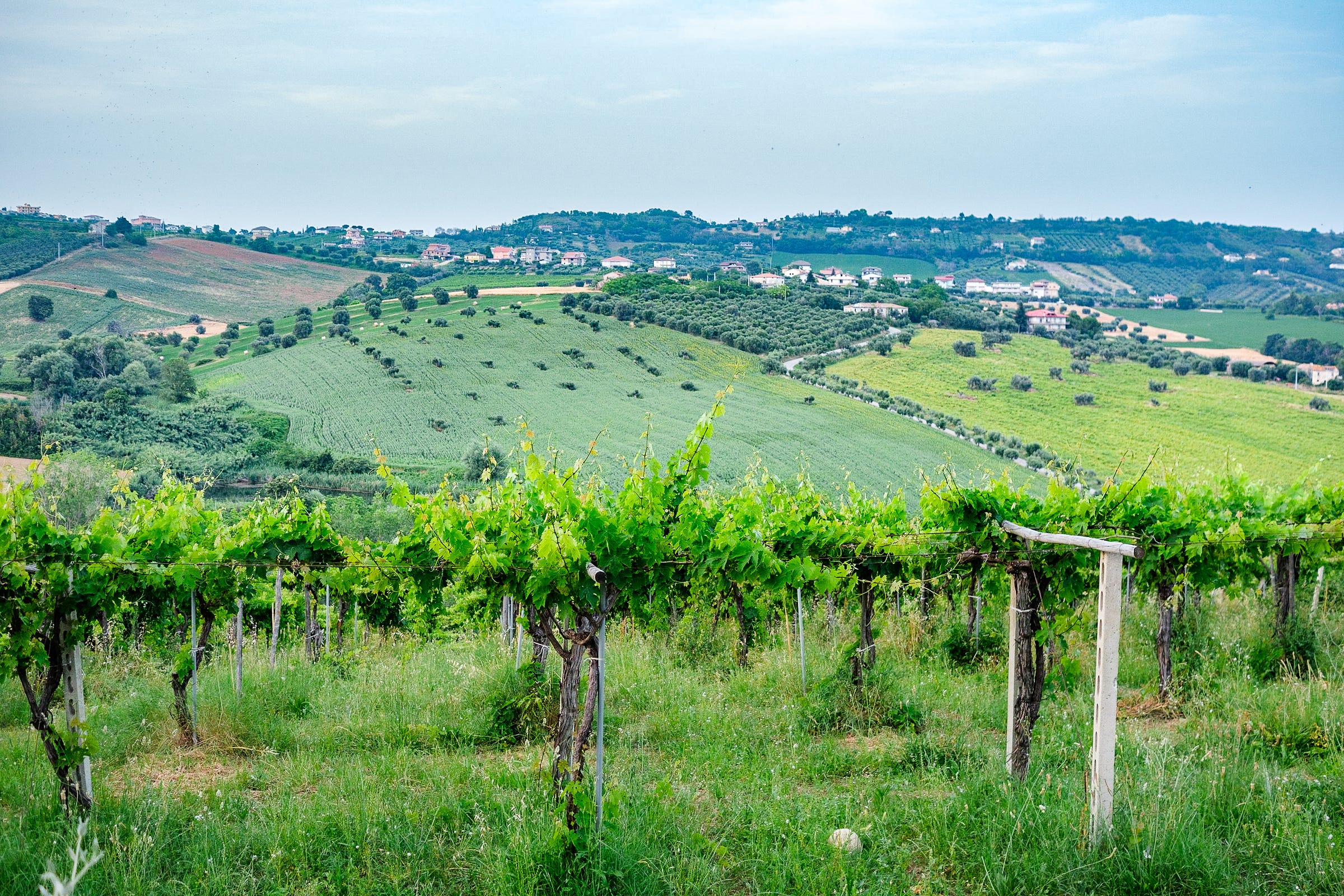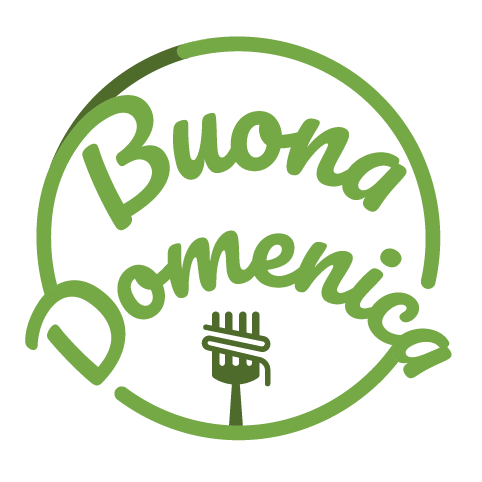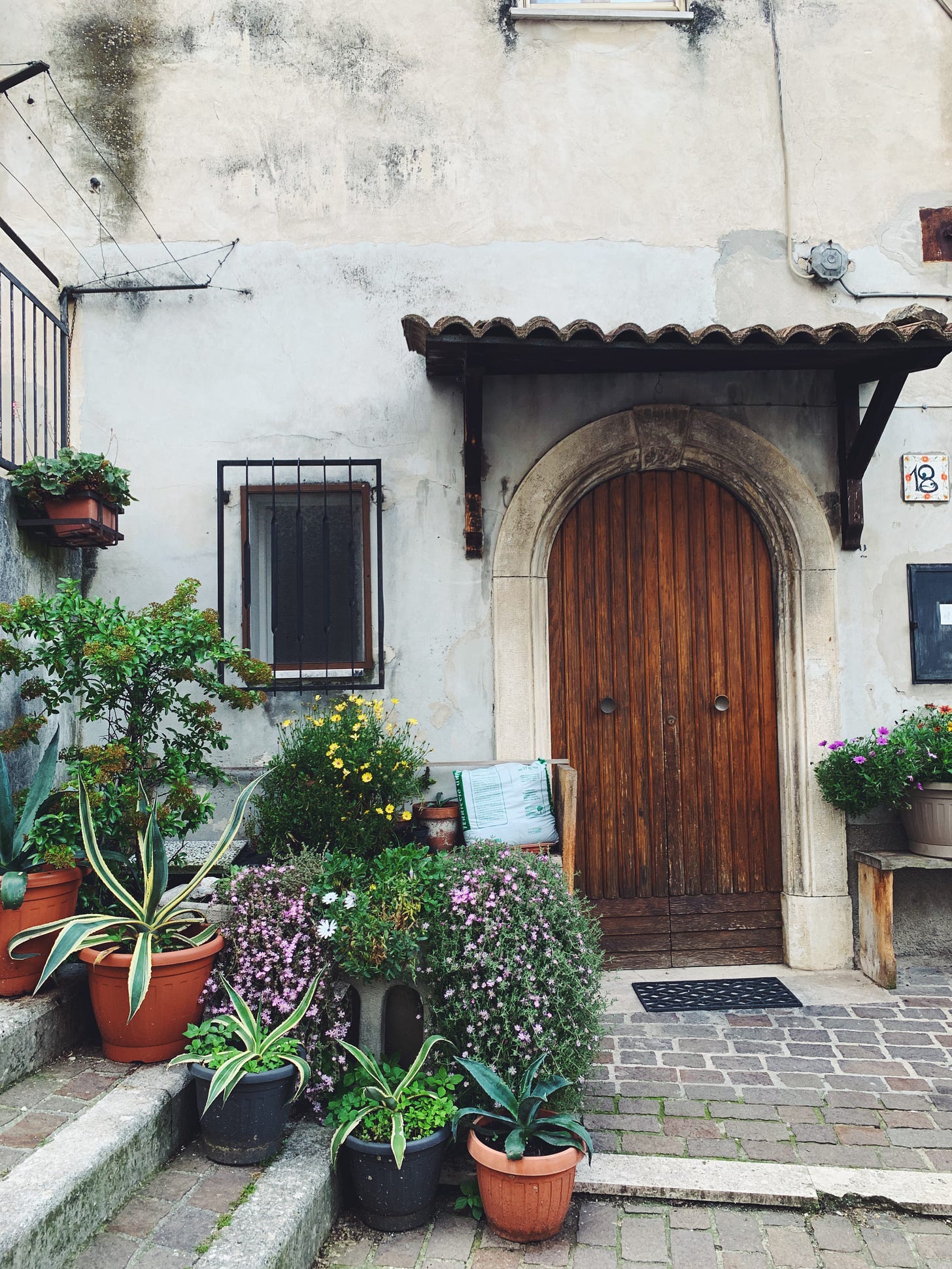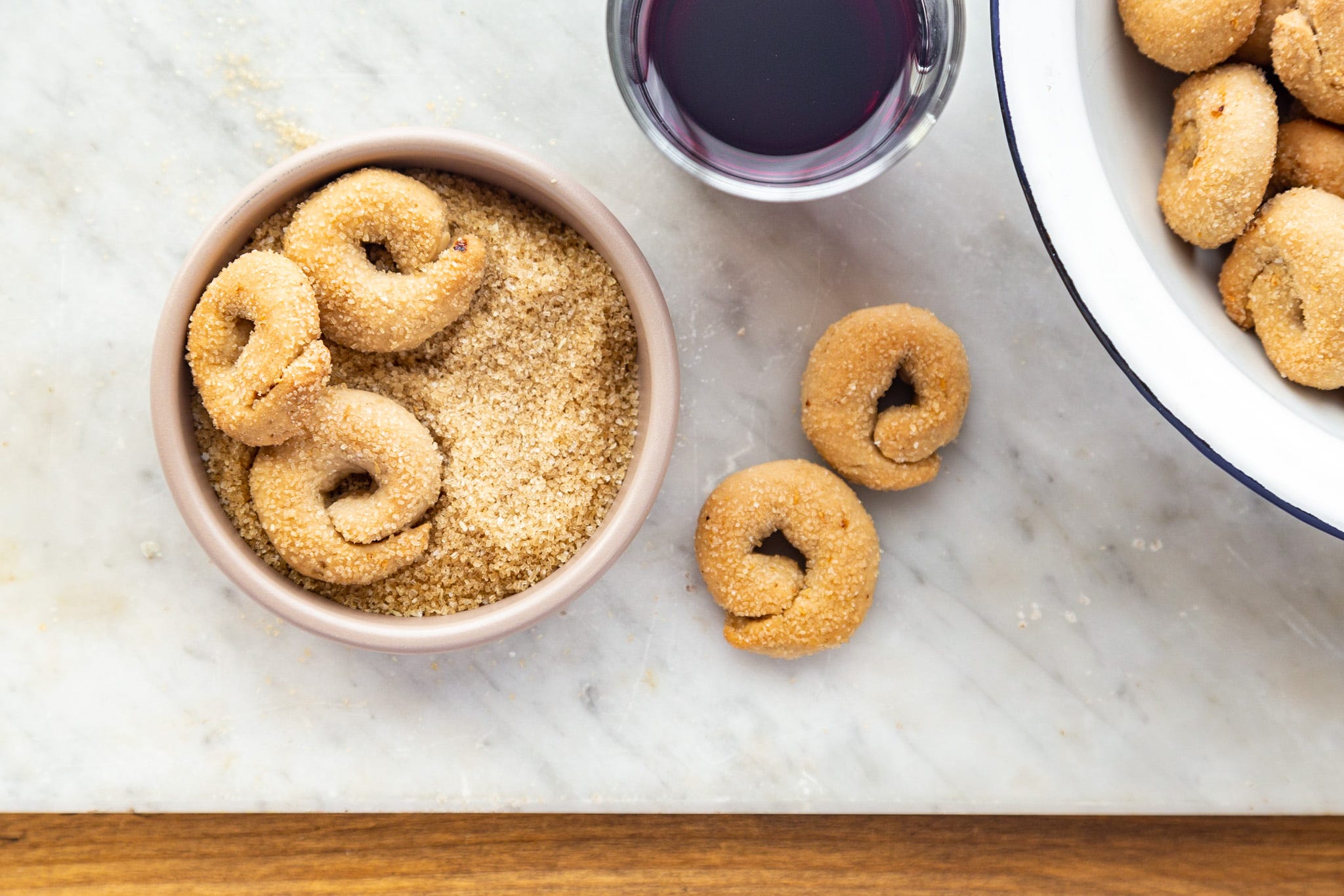A week dedicated to Abruzzo and a pantry Q&A with Domenica Marchetti
Plus two recipes for you, including Domenica's Wine Cookies for Dipping
This newsletter is a reader-supported publication. We’re trying to keep things as free as possible, but if you enjoy what I write and want access to exclusive weekly recipes, and if you are at a point in your life to support our newsletter, please consider becoming a paid subscriber. Thank you!
We’re back from our weeklong holiday in Alba Adriatica, on the Northern Coast of Abruzzo. As anticipated, we didn’t even move the car from the hotel garage to visit this charming area, except for a dinner out in a local agriturismo lost in the verdant hills (but I’ll tell you more about this on Friday with the next guest).
So I thought I’d ask two friends with deep connections to Abruzzo to share something more about this Italian region, nestled between the Gran Sasso and Majella mountain ranges and the Adriatic Sea.
We fell in love with the area last year, when driving back home from Salento we stopped halfway for a night. That’s where our love story with Abruzzo began. We’re already planning our next trips and holidays there: there’s so much to see, and taste!
Today I’m chatting - again! -with
. Domenica Marchetti is a food writer, and author of many cookbooks, including Preserving Italy (one of my favourite and most used preserving books), and also the author of one of my favourite newsletters here on Substack, , where she shares recipes, interviews, and inspiration. She also teaches in-person and online cooking classes, and hosts tours and workshops in Italy.You can read more about Abruzzo from the newsletter archive:
Domenica’s first guest post here on Letters from Tuscany, Gabriella’s ravioli, about her mom’s Abruzzese-style ricotta ravioli.
A Q&A with Laura Ottaviantonio, about her recipes and stories between Abruzzo, Rome and the countryside, her gluten-free, inclusive pantry and Abruzzo amaretti cookies.
And now, to Domenica, who is also sharing two recipes from her latest book, Everyday Italian Cookbook (one is behind paywall).
Thank you so much, Domenica, for your time. Let’s start chatting about the pantry! What is your relationship with the pantry? and what has been the role of the pantry in your family?
I rely on my pantry for so many things, from the basics like olive oil, dried pasta, and Parmigiano cheese to tinned anchovies, capers, honey and Nutella.
What is the one ingredient that just cannot be missing from your ideal pantry?
This is such a difficult question! Good olive oil and a chunk of Parmigiano-Reggiano come to mind, but I’m going to go with something else: Rizzoli Alici in Salsa Piccante. These are tinned anchovy fillets preserved in a piquant sauce of olive oil, peperoncino, and tuna. My mom always had a stack of tins of these anchovies in her pantry. We could not get them in the U.S., so she would bring home dozens of tins from Italy at the end of every summer, packing them into our suitcases, along with big pieces of Parmigiano cheese and ceramics from Castelli (Abruzzo). Our luggage was very heavy!
If you had to describe your pantry in one word, what would it be?
The word that comes to mind is ‘eclectic’ because, in addition to Italian ingredients, I also have a selection of Asian ingredients, such as fish sauce, rice vinegar, and rice noodles, as well as Middle Eastern ingredients like harissa, bulgur, and red lentils. And, of course, my favorite American ingredient: maple syrup. But I confess the large majority of what I keep in the pantry is Italian.
Your mum was from Abruzzo. What are the most important and relevant ingredients of the Abruzzo cuisine?
People don’t realize the diversity that exists in the ingredients and cooking of Abruzzo. Between the Gran Sasso and Majella mountain ranges and the Adriatic Sea, there are many microclimates, and this makes for an impressive variety of ingredients. Here are a few that come to mind immediately:
Sheep’s milk cheeses: For centuries, Abruzzo relied on a pastoral economy. The shepherding life is difficult and over the years the region has suffered the loss of sheep and those who raise them. But raising sheep and the production of sheep’s milk cheeses is still a vital part of the region’s culture and life. Abruzzo has an enticing variety of sheep’s milk cheeses, from semisoft to piquant aged suitable for grating. In fact, when the Abruzzesi eat pasta, they are more likely to sprinkle pecorino on it rather than Parmigiano.
Lamb: Connected to the pastoral economy and the production of pecorino cheese is, of course, lamb, including mutton and castrato. The meat is fresh and flavorful without being too intense. In Abruzzo, lamb is served grilled simply, with roast potatoes. It is also an ingredient in Abruzzese ragù. Agnello cace e ove (lamb with pecorino cheese and eggs) is a very traditional dish, typically served at Easter. Chunks of lamb are cooked in a pan and finished with a sauce made from beaten eggs and cheese. It’s unusual and delicious (and you can find the recipe in Cucina Povera, p. 80!).
Olive oil: Many people don’t realize that Abruzzo produces excellent olive oil from a variety of olives that grow in the region. There are different styles, but Abruzzese olive oil is typically a bit piccante (spicy) and contains notes of artichoke, tomato leaves, grass, and almond.
Peperoncino: Almost any restaurant you go to in Abruzzo will have peperoncino at the table. Sometimes it is a single, long fresh green pepper presented on a plate with a small pair of scissors so that you can snip a few pieces on your dish of pasta. Or, it might be dried red peppers, or peperoncino sott’olio. Olio santo is the oil in which the peppers have been steeped. It is extremely spicy!
Grapes: Winemaking is important in Abruzzo. The region is most famous for its Montepulciano d’Abruzzo, but you will also find Trebbiano, Pecorino, and a lesser-known white grape called Coccociola from the province of Chieti. In addition to Montepulciano d’Abruzzo wine, the Abruzzesi also use the grape to make mosto cotto, a syrup made by reducing grape must over the stovetop; and scruccjata, a rustic grape jam that is used as a filling for cookies and crostata.
Adriatic seafood: There’s a delicious variety of small fish and seafood in the waters of the Adriatic. Among the fishes are anchovies, sardines, mackerel, mullet, and redfish. Seafood includes octopus, squid, cuttlefish, clams, razor clams, mussels, shrimp, and (my favorite) pannocchie or cicale di mare, known as mantis shrimp in English. If you travel to Abruzzo, you must have brodetto, a rich stew that contains many of these fish and seafood in a tomato-based broth. It’s incredible. (There’s a recipe for brodetto in Cucina Povera, too! Check at page 131)
Abruzzo is also known for excellent dried pasta!
How would you define the Abruzzo style of cooking?
Like all regions of Italy now, Abruzzo has its share of Michelin-starred restaurants and even celebrity chefs, such as Niko Romito. But I still consider the cuisine of Abruzzo to be simple, genuine, and local; a cuisine that relies on excellent ingredients from the land and sea. There is nothing better than a plate of arrosticini hot off the grill, cooked over hot coals with nothing more than a sprinkle of salt. If you are lucky enough to be enjoying them at a ristoro with a view of the Gran Sasso in the background, they taste even better. To me, the beauty of Abruzzese food is inextricably tied to the beauty of the region.
Is there a recipe you are particularly fond of that perfectly represents Abruzzo's cuisine?
It’s hard to limit my answer to one recipe, since Abruzzo’a cuisine is so diverse. One that I haven’t mentioned yet is polenta alla spianatoia, which is something you eat only in winter in the mountains. After you’ve cooked a pot of polenta, while it is still hot, you pour it out onto a large board called a spianatoia. Then you spoon ragu made with a mix of meats (lamb, pork, sausages) on top of the polenta. Everyone claims a spot on the spianatoia and communal eating ensues. It’s a very old-fashioned, convivial way of enjoying a meal together.
Is your pantry different in your house in Penne, in Abruzzo, and in your American house?
My pantry in Penne is much smaller than my American pantry, and I try to buy locally produced ingredients, so it is a mostly Abruzzese pantry: honey from a producer in the province of Chieti; onions preserved in oil, from a Penne producer; lentils from Santo Stefano di Sessanio; and fagioli tondi del Tavo, small, round white beans grown nearby along the banks of the River Tavo.
And now, let's talk about your latest cookbook, Everyday Italian Cookbook, where you share some of your favourite Italian recipes. What is, for you, that makes a recipe Italian?
This is a great question, but it’s a complicated one that is getting harder and harder to answer. As someone who was raised in an Italian family but who grew up in the United States, my definition of “Italian” is likely different from someone who was born and raised in Italy. The book has a range of traditional regional recipes that so many of us are familiar with: bucatini cacio e pepe, penne all arrabbiata, brodetto (as I’ve already talked about), roasted peppers, tagliata di manzo (sliced beef steak), amaretti cookies, and torta caprese (check the recipe for torta caprese in the newsletter archive), the famous chocolate almond cake from Capri—to name a few. But there are also recipes that I created in my kitchen that may not be traditional but that start from the point of tradition. For example, pizza with rapini and scamorza; creamy polenta with summer vegetable stew, chicken ricotta meatballs, fig and wine gelato. They might not be traditionally Italian but they are Italian in concept and in spirit.
Would you like to share an Abruzzese recipe from Everyday Italian Cookbook, something you can keep in your pantry?
It would be my pleasure. The following is a favorite from childhood: biscotti al vino, or wine cookies. They are made with olive oil, Montepulciano d’Abruzzo wine, and aniseed. They are rustic in appearance and crunchy in texture and perfect for dunking in wine or coffee.
Domenica is sharing also her recipe for Guitar-Cut Spaghetti with Zucchini and Saffron Cream (paywalled). Spaghetti alla Chitarra is a pasta shape that, until recently, you would only find in Abruzzo. It’s a thick, square-cut spaghetti made with an instrument called a chitarra (guitar). Find the recipe here:
Spaghetti alla Chitarra with Zucchini and Saffron Cream by Domenica Marchetti
RECIPE - Biscotti al Vino | Wine Cookies for Dipping
Recipe from Williams-Sonoma Everyday Italian.
These rustic cookies are typical of Abruzzo and Lazio, the region that includes Rome. The ingredients evoke the harvest season: wine and olive oil are the primary components, along with flour, sugar, and aniseed.
The cookies can be made with white or red wine, but in Abruzzo, it is customary to use Montepulciano d’Abruzzo. You can add a pinch of baking powder or baking soda to give them an airier texture, but I prefer them dense and crunchy—just right for dipping into a glass of wine or mug of coffee.
Makes 40 to 50 cookies
¾ cup (180 ml) Montepulciano d’Abruzzo wine
¾ cup (180 ml) extra-virgin olive oil
¾ cup (150 g) granulated sugar, plus more for dipping
4½ cups (540 g) unbleached all-purpose flour
¼ teaspoon fine salt
2 teaspoons aniseed
1. Pour the wine, oil, and sugar into the bowl of a stand mixer fitted with the paddle attachment. Mix on low to help dissolve the sugar. Add in three-quarters of the flour, the salt, and the aniseed, and mix on low until the flour is absorbed. If the mixture is sticky, sprinkle in more flour until the dough comes together. It should be dense, somewhat ragged, and shiny.
2. Turn the dough out onto a clean, lightly floured work surface and knead it briefly. It will be somewhat rough-textured. Form it into a ball, cover it with a bowl, and let it rest for 30 minutes.
3. Heat the oven to 375°F (190°C). Line two rimmed baking sheets with parchment.
4. Fill a small bowl with sugar. Cut off a golf ball-sized piece of dough and roll it into a rope about 4 inches (10 cm) in length and slightly thinner than your pinkie. Note that this oil-rich dough tends to break apart as you roll. Simply press it together and re-roll. Bring the ends of the rope together and pinch to form a ciambella (ring), or cross one end over the other to make a torcetto (cross). Dip the top of the cookie into the sugar to coat it and place it on a prepared baking sheet. Continue shaping and dipping, spacing the cookies about 1 inch (2.5 cm) apart on the pans.
5. Bake one pan at a time for 20 to 22 minutes, until the cookies are browned along the edges. Let them cool for a few minutes on the baking sheet and then transfer them to a rack to cool completely. Store them in a tin, where they will last for at least a week, unless you eat them sooner (you will).
If you make this recipe, share it via email and send me a picture at juls@julskitchen.com, or on Social Media using the hashtags #myseasonaltable #julskitchen and #lettersfromtuscany #buonadomenica, and tag @julskitchen and @domenicamarchetti










Thank you, Giulia, for shining a light on Abruzzo and for the opportunity to talk about my favorite region and cuisine, and what's in my pantry!
You are whetting my appetite for a trip to Abruzzo. I’m already hooked on adriática seafood and all things Adriatic from trips to Istria and Croatia, but now you have me plotting a whole summer in Italy. 🤍